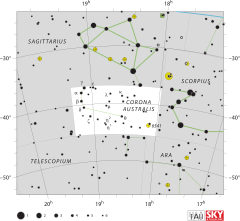Beta Coronae Australis
| Observation data Epoch J2000.0 Equinox J2000.0 (ICRS) | |
|---|---|
| Constellation | Corona Australis |
| Right ascension | 19h 10m 01.75580s[1] |
| Declination | −39° 20′ 26.8644″[1] |
| Apparent magnitude (V) | 4.10[2] |
| Characteristics | |
| Spectral type | K0II/IIICNIb[2] |
| U−B color index | +1.07[3] |
| B−V color index | +1.20[3] |
| R−I color index | +0.61[3] |
| Astrometry | |
| Radial velocity (Rv) | 2.7±0.9[2] km/s |
| Proper motion (μ) | RA: 4.37[1] mas/yr Dec.: −36.65[1] mas/yr |
| Parallax (π) | 6.88 ± 0.25[1] mas |
| Distance | 470 ± 20 ly (145 ± 5 pc) |
| Absolute magnitude (MV) | −1.71[2] |
| Details | |
| Radius | 41.07+4.32 −3.76[4] R☉ |
| Luminosity | 693.5[2] L☉ |
| Temperature | 4,771[5] K |
| Other designations | |
| Database references | |
| SIMBAD | data |
Beta Coronae Australis, Latinized from β Coronae Australis, is a single[7] star in the southern constellation of Corona Australis.[6] It is visible to the naked eye as a faint, orange-hued star with an apparent visual magnitude of 4.10.[2] The star is located around 470 light years distant from the Sun based on parallax,[1] and is drifting further away with a radial velocity of +3 km/s.[2]
This is an aging K-type giant/bright giant star with a stellar classification of K0II/IIICNIb,[2] where the suffix notation indicates an abundance anomaly of CN in the spectrum. Having exhausted the supply of hydrogen at its core, the star has expanded to 41 times the girth of the Sun.[4] It shines with a luminosity approximately 694[2] times that of the Sun and has a surface temperature of 4,771 K.[5]
References[]
- ^ a b c d e f van Leeuwen, F. (2007), "Validation of the new Hipparcos reduction", Astronomy and Astrophysics, 474 (2): 653–664, arXiv:0708.1752, Bibcode:2007A&A...474..653V, doi:10.1051/0004-6361:20078357, S2CID 18759600.
- ^ a b c d e f g h i Anderson, E.; Francis, Ch. (2012), "XHIP: An extended hipparcos compilation", Astronomy Letters, 38 (5): 331, arXiv:1108.4971, Bibcode:2012AstL...38..331A, doi:10.1134/S1063773712050015, S2CID 119257644.
- ^ a b c HR 7259, database entry, The Bright Star Catalogue, 5th Revised Ed. (Preliminary Version), D. Hoffleit and W. H. Warren, Jr., CDS ID V/50. Accessed on line September 5, 2008.
- ^ a b Brown, A. G. A.; et al. (Gaia collaboration) (August 2018). "Gaia Data Release 2: Summary of the contents and survey properties". Astronomy & Astrophysics. 616. A1. arXiv:1804.09365. Bibcode:2018A&A...616A...1G. doi:10.1051/0004-6361/201833051. Gaia DR2 record for this source at VizieR.
- ^ a b McDonald, I.; et al. (2012), "Fundamental Parameters and Infrared Excesses of Hipparcos Stars", Monthly Notices of the Royal Astronomical Society, 427 (1): 343–57, arXiv:1208.2037, Bibcode:2012MNRAS.427..343M, doi:10.1111/j.1365-2966.2012.21873.x, S2CID 118665352.
- ^ a b * bet CrA -- Star, database entry, SIMBAD. Accessed on line September 5, 2008.
- ^ Eggleton, P. P.; Tokovinin, A. A. (September 2008), "A catalogue of multiplicity among bright stellar systems", Monthly Notices of the Royal Astronomical Society, 389 (2): 869–879, arXiv:0806.2878, Bibcode:2008MNRAS.389..869E, doi:10.1111/j.1365-2966.2008.13596.x, S2CID 14878976.
- K-type bright giants
- Corona Australis
- Bayer objects
- Durchmusterung objects
- Henry Draper Catalogue objects
- Hipparcos objects
- HR objects
